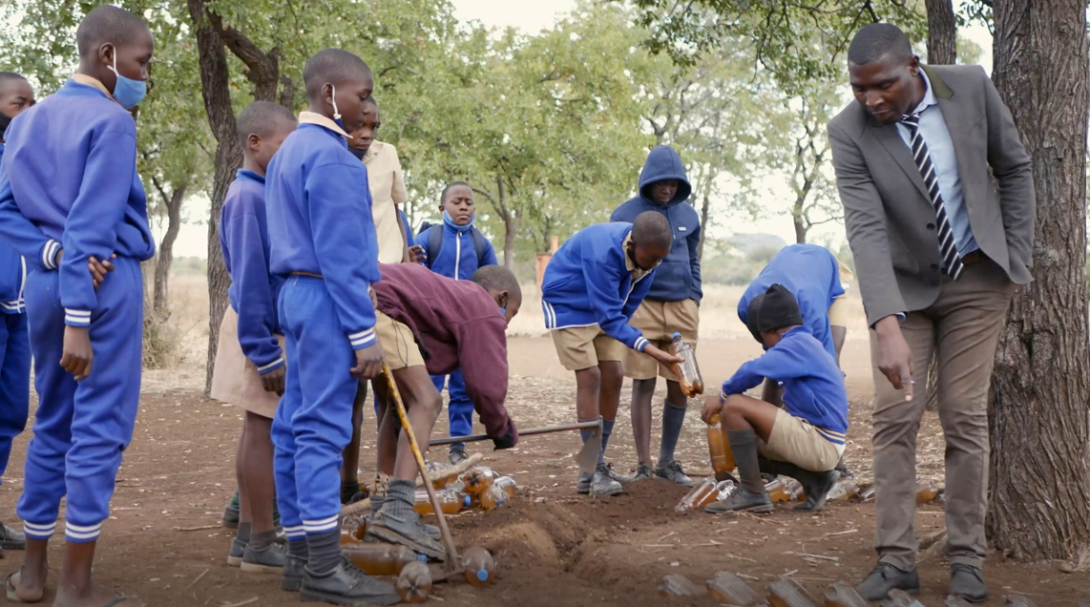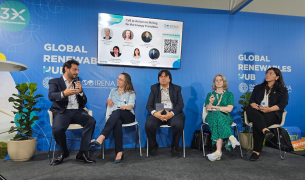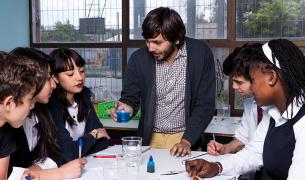Climate education is our responsibility in a climate-changed world

Tiyiso Mbeleji is a 14-year-old Teach For Zimbabwe student and a member of Teach For All's Student Leader Advisory Council who has experienced first-hand the struggles caused by climate change. In her home region of Chiredzi, which is in climatic region five, girls like Tiyiso have witnessed their surroundings turning into a desert, forcing them to walk unimaginable distances in unfriendly environments to fetch water and firewood to use at home. Persistent drought, interrupted only by the rare burst of heavy rain, has become the norm and her community has suffered from the extreme unpredictability and predominant scarcity of water. Climate change has transformed the daily lived reality of kids like Tiyiso: many of them, especially those living in marginalized communities, are now experiencing climate change-induced extremes—not only drought, but also heat waves and violent storms—that lead to the destruction of homes and livelihoods, forced migration, and greater vulnerability to health threats. Not seldom, these impacts cause psychological trauma in the children in these communities.
Our shifting global reality
More and more, Tiyiso and her community’s experiences are becoming the new global normal. On every continent, average temperatures are on the rise and extreme weather events like violent storms and drought have become more frequent and severe. As we write this article, roughly one-third of Pakistan is flooded, resulting in over 1,400 lives lost (one-third of which were children) and 33 million people displaced from their homes. In late July, sudden heavy rains in Uganda following a dry spell that had caused large-scale crop failures, led to flooding and mudslides claiming 20 lives in one day. The list goes on, ranging from record temperatures and drought recorded in parts of the UK and France, to heat waves in China (the most severe one ever recorded there), India and the western United States, to wildfires, storms, and floods across the globe.
This year of record-breaking heat and extreme weather has resoundingly manifested two realities: first, climate change impacts are no longer a distant, abstract threat, to be worried about in the future. Rather, they are today’s reality—here and now. Second, while some regions and communities are particularly harmed by climate change, the impacts are felt globally. This is a lived reality for all of us, with the effects and scope expected to further worsen over time. In other words, the long-standing view that the impacts of climate change are “tomorrow, somewhere else, and not bad enough to act,” which was long prevalent especially in many parts of the global North, is no longer plausible.
Extreme weather has always existed. But it is now clear just how frequent and universal it is becoming and that human-caused climate change plays a very significant role in all this. In recent decades, humans have become the main force of geological change at planetary scale, altering the climate and ecosystems, and thereby creating increasing unpredictability and instability of geological conditions. Some heating is already inevitably “locked into” our atmosphere and average global temperature will definitely rise to 1.5 degrees Celsius above pre-industrial levels by 2040, no matter what happens to emissions. But, there is a lot we can do—and must do—to limit the number of people whose lives are severely impacted or cut short either directly or indirectly by climate change. We have a collective responsibility to make sure that today’s children are resilient and have the skills, mindsets, tools, and support they need to live and thrive in a more volatile and unpredictable world.
Key implications for education
At Teach For All, we believe that the purpose of education is to enable all students to fulfill their potential and shape a better future for themselves, their communities, and the world. For today’s students climate change is a tangible, personal, urgent, and locally felt problem. They live in a world where humans need to adjust to a climate-changed reality, while still having collective agency for limiting the degree of planetary change. This new reality has two broad central implications for education:
First, how we make use of our collective human agency over shaping the course of our planet will depend on how well we prepare students to pioneer the necessary solutions to the climate crisis and lead a green transformation. Students need to learn, in their own contexts, about the reality and drivers of climate change and to experience their agency, self-efficacy and options for engaging in climate solutions.
Second, the certainty of a climate-changed world requires students to be resilient and equipped to cope with the effects that are here now. As Harvard University historian Ian Miller puts it: “Climate change is not simply climate change anymore. It is ‘everything change.’” Increasingly more of our students live in communities that need to adapt and innovate in order to secure people’s livelihoods, safety, and health. Being resilient and equipped for this lived reality requires students to gain 21st century skills like creativity, problem-solving, collaboration, self-regulation, and solidarity. This equipping of students to confront the reality of a climate-changed world is an equally vital part of climate education.
The way forward
Fortunately, there is much progress and leadership to learn and build from, including in Teach For All’s global network. There are numerous network teachers who embody climate leadership and a strong sense of possibility, and who unlock both of these in their students. For example, Ahmad El Baghdadi, a Teach For Lebanon fellow, led a Sustainability Innovation Camp where students learned about the importance of renewable energies and how to apply and relate them to their day-to-day lives. Given Lebanon’s prolonged electricity crisis—with very limited centrally provided electricity each day—the knowledge and skills that students gained at the camp are timely, relevant, and beneficial for their local community. There is also Ojashwi KC, a Teach For Nepal alumna, who mentored her students on a project in which they designed a solar-halo (an alternative to the traditional plowing tool and harmful modern tractor) to combat climate change and energy poverty, for which they won a global competition. And Egoitz Etxeandia, an Empieza por Educar (Spain) alumnus, engages his students in hands-on circular economy projects, such as Funghi Thinking, that help students learn to identify and lead concrete ways to eliminate waste and reduce greenhouse gas emissions in their local context.
These are only some of the examples of incredible climate education leadership from our network (our global Climate Education Community brings together more than 300 inspiring climate education leaders). What unites these leaders is that they engage students in practical, solutions-oriented activities that focus on designing or improving local climate change solutions—be it solar energy in Lebanon, farming innovations in Nepal, or a circular economy in Spain. They do so by enabling, rather than lecturing, their students, and giving them space to surface their ideas, creativity, emotions, and spirit of collaboration. And they help students see disciplines like math, language, and science as tools for making sense of our world and shaping a better future—thereby transcending the context of the classroom, with life-long relevance. Further, they support students from some of their countries’ most disadvantaged communities to realize their potential, positioning those who suffer the most from climate change impacts to lead efforts to address them. Lastly, they stimulate students’ curiosity and concern for our planet in tangible ways, so that climate action becomes part of their identity and the lens through which they see the world.
Of course, these initiatives will not eradicate climate impacts that are already underway. Communities in Pakistan, Uganda, and other places that have been struck by environmental disaster need our rapid support and immediate disaster relief to reduce suffering, restore livelihoods, and safeguard vital infrastructure today. However, we also have to recognize these catastrophes as a wake-up call to do everything we can to mitigate climate change and empower the next generation to become resilient and skilled leaders and problem-solvers in their communities. Now, more than ever, climate education is vital for students to confront this time of instability and uncertainty and meet the needs of the 21st century.
Learn more about the Teach For All Climate Education and Leadership Initiative.



